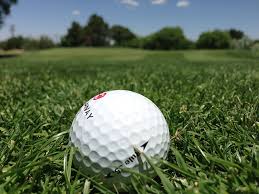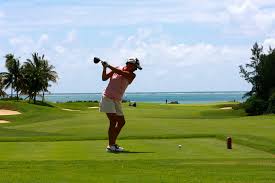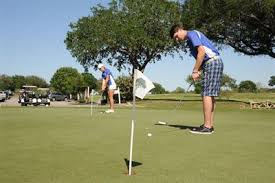Sport Rehabilitation and Physiotherapy for Golf
 There are millions Golfers in Great Britain and the average age of golfers who play at least once a week is 63. As the population ages, golf is likely to become an increasingly popular leisure time activity because it allows a variety of individuals, regardless of skill, gender, or age to play simultaneously. A survey of 163 British amateur golfers reported that 57% had sustained golf related injuries in a single year. Overuse is one of the main causes of injury. In 2003 Gosheger showed that 90% of back and upper limb injuries were related to overuse. They also suggested that the risk of injury increased if 4+ rounds were played or over 200 balls were hit each week. It is likely that as the number of golfers increases (especially when mixed with an aging population), the number of golf related injuries may also be expected to rise.
There are millions Golfers in Great Britain and the average age of golfers who play at least once a week is 63. As the population ages, golf is likely to become an increasingly popular leisure time activity because it allows a variety of individuals, regardless of skill, gender, or age to play simultaneously. A survey of 163 British amateur golfers reported that 57% had sustained golf related injuries in a single year. Overuse is one of the main causes of injury. In 2003 Gosheger showed that 90% of back and upper limb injuries were related to overuse. They also suggested that the risk of injury increased if 4+ rounds were played or over 200 balls were hit each week. It is likely that as the number of golfers increases (especially when mixed with an aging population), the number of golf related injuries may also be expected to rise.
Common Golf injuries
There is a lot more to golfing injuries than the golfers elbow! Research has shown the following breakdown of golfing injury between professional and amateur golfers.
| Body part | Professionals |
Amateurs |
| Lower back | 23.7% | 34.5% |
| Wrist | 26.% | 20.1% |
| Elbow | 6.6% | 33.1% |
| Shoulder | 9.4% | 11.7% |
| Knee | 6.6% | 9.3% |
| Neck | 3.1% | 4.0% |
| Hip | 1.1% | 3.1% |
| Ribs | 3.1% | 3.1% |
| Ankle | 2.0% | 2.5% |
| Foot | 3.3% | 1.7% |
As expected the lower back scores highest for both groups. This is what Sugaya in 1998 described as “The Crunch Factor”, whereby a right handed player would get predominantly right sided low back pain due to trunk rotation combined with sideways bending force during the swing.
As you can see from the table, the low back and elbow is injured significantly more in amateurs as compared to professionals. This is likely due to better technique in professionals in which a smoother strike of the ball reduces the tension in the back and elbows.
Interestingly, the hip scores low, but we do see plenty of golfers with hip pain in clinic. Studies have shown that in right handed golfers there are high compressive pressures through the left hip during the swing. This may lead to a higher predisposition to degenerative changes (osteoarthritis) in swing types in which there is a greater hip sway or slide towards the target. I feel that this is why older golfers get hip pains.
Reducing the risk of Golf related injuries
 To reduce the risk of injury in golf we need to apply the basic principles of “exercise preparation” but then make it specific to the physical demands of golf. This should be basically divided into “pre-exercise preparation” and “long term athletic development”.
To reduce the risk of injury in golf we need to apply the basic principles of “exercise preparation” but then make it specific to the physical demands of golf. This should be basically divided into “pre-exercise preparation” and “long term athletic development”.
Pre-exercise preparation
A study by Fradkin in 2001 showed that only 54% of amateur golfers performed a warm up which places 46% of golfers at higher risk of injury. A thorough warm up of the entire body should be performed to increase the temperature of muscle and joint and to make them more flexible and “switched on” for performance. This can include gentle, rhythmic movements (running on the spot for example). It is then beneficial to ease into more golf specific exercises, such as, trunk rotations in sitting or tee off position, rotational stretches of the shoulders and hip/ ankle movements.
Long term athletic development
If we break down the physical demands of the golf swing we can see that lots of specific movements are needed at a variety of joints as well as strength. For example, lateral rotation of the right shoulder, trunk rotation, core stability, medial rotation at the left hip (to name a few). Specific conditioning exercises should be developed and progressed as part of an underlying training programme. The programme should look at the overall demands of golf and ensure that the golfer is on track to meet those demands. This is an ongoing process which will need regular revision.
Treatments following Golf related injury
 The assessment and treatment techniques of golfing injuries are grounded in sound biomechanical and physiological principles. Two forms of assessment are offered:-
The assessment and treatment techniques of golfing injuries are grounded in sound biomechanical and physiological principles. Two forms of assessment are offered:-
Basic physio assessment:- If a pain is extremely acute (recently occurring) then an assessment is needed to assess the structures at fault and devise an early stage treatment plan to settle symptoms.
Full biomechanical assessment:- In most cases, however, the golfer has ongoing aches and pains which is likely derived by biomechanical factors. In such cases a 60 minute biomechanical assessment is recommended whereby the therapist can perform a whole body assessment of your movement and strength and compare this to what is required. There is also a biomechanical analysis of your golf swing. This assessment is available on special request.
Golf Injury Specialist

All our therapists are more than capable of treating golfers, however, John is our expert in this field. He acts as first contact for all other therapists and provides in-service training to ensure all the team are up to date with the latest research and developments. John “formalised” his knowledge in early 2013 by successfully completing “The Golf Athlete, level 1” as taught by experts Michael Dalgleish and Dr Robert Neal.
We have clinics located in Wirral, Stockport, Salford, Middleton and Manchester so please Contact Us to book an appointment.
